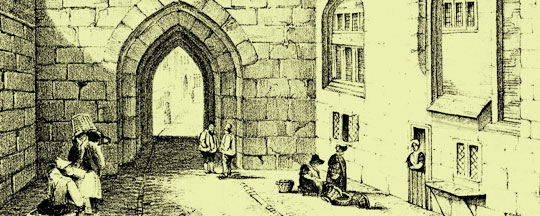Home » Yesterday » Birth of a Street

Far Gosford Street was the main route out of medieval Coventry towards Leicester and London. Where the original track crossed the River Sherbourne was the ‘Goose Ford’ – the origin of ‘Gosford’. There were already houses fronting the street as early as the 12th century and it is possible that the medieval suburb was laid out in a planned manner. The street pre-dates the town wall and after construction of the wall (C14th – C16th) it became Far Gosford Street denoting its location beyond the wall. The extra-mural suburbs, being outside the formal city suffered less tax and control. This alternative society of artisans continues to this day and is at the core of its regeneration.
In the early days craftsmen in the city formed the first of the city’s guilds and congregated in areas according to their trade. The metalworkers and locksmiths dominated the street in the thirteenth century, with the weavers and drapers taking over in the 14th and 15th centuries. Coventry was one of the most prosperous cities in England during the late medieval period. At this time the street was crammed with a variety of trades and crafts, most notably of the woollen industry including weaving, wool combing, dyeing, and fulling – the cleaning and thickening of cloth
The 18th century saw the arrival of the Huguenots from France escaping religious persecution. They brought silk and ribbon weaving, which came to be the dominant trade in the street. The distinctive ‘top shops’ associated with this trade appeared in various parts of the street and the grade II-listed row at Nos. 67-72 remains as a good example of this building type.